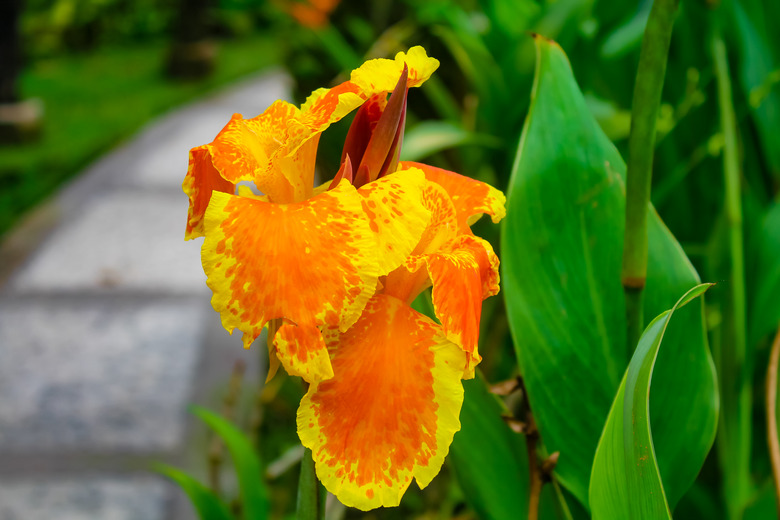Bugs Are Eating My Canna Lily Leaves
We may receive a commission on purchases made from links.
Maybe it's their color palette, ranging from chartreuse to nearly black with rainbow stripes thrown in for good measure, or maybe it's their enormous size. For whatever reason, canna lily (Canna spp.) leaves look too appetizing for an assortment of hungry canna lily pests to ignore. Whether grown as perennial garden fixtures in U.S. Department of Agriculture plant hardiness zones 7 through 10 or as container plants overwintered indoors elsewhere, cannas are likely to host at least one of these unwelcome diners. The good news is that all of them are manageable with planet-friendly methods.
Common Canna Lily Pests
Common Canna Lily Pests
Larger canna leaf rollers pull the edges of the leaves over themselves. Lesser canna leaf rollers typically infest canna leaves before they unfurl. Both pests stitch their shelters shut with silk threads; the unfurled ones never open. Lesser rollers eat only the inner leaf tissue layer, while larger ones eat the entire leaf. Pale green, white-striped celery leaftiers, also known as greenhouse leaftiers, fold part of a leaf, bind the folded sections with fine webbing, and feed inside. Affected leaves have ragged holes.
Rows of holes on newly opened canna leaves are the work of cream-striped, yellow, green, or black corn earworms. Venomous bristles and brown-and-white bull's-eyes on their bright green backs make saddleback caterpillars hard to miss. Other occasional visitors are fuzzy saltmarsh and white, yellow, or red-orange woolybear caterpillars. To protect yourself from stinging saddlebacks, wear heavy gloves, a long-sleeved shirt, and long pants when handling them.
Controlling Canna Lily Caterpillars
Controlling Canna Lily Caterpillars
For cultural control, prune rolled or folded leaves as soon as you notice them and dispose of them in sealed plastic bags. Hand-pick surface-feeding caterpillars and drown them in soapy water. To avoid spreading disease, prune the leaves with clean, sharp stem cutters disinfected between cuts in rubbing alcohol.
Organic Bt spray kills caterpillars by disrupting their digestive tract. It's most effective right after they hatch. Treat the plants with a solution of 1 tablespoon (or the label's recommended amount) of Bt concentrate diluted in 1 quart of water. Spray until the solution covers both sides of all the leaves. Time the spray for early morning or late evening when no bees are likely to visit the cannas for at least three hours. Repeat the treatment as needed while the caterpillars are hatching.
Other Canna Lily Pests
Other Canna Lily Pests
Aphids, mealybugs, and armored scale insects occasionally attach to canna leaves and drain their sap. Aphids and mealybugs also drench them with gooey, clear waste. Blasting the leaves with hose water dislodges the aphids and mealybugs. Scraping off scales with a soft toothbrush damages their plant-piercing mouth parts so they can't reattach. In severe infestations, you can use an insecticide for canna lilies, like insecticidal soap for aphids, and treat mealybugs and scale with horticultural oil, applying it according to package directions.
Between late spring and midsummer, iridescent, emerald, and copper Japanese beetles often chew canna leaves to ribbons. Hand-pick and drown the earliest arrivals in soapy water before they release mate-attracting pheromones. If that isn't enough, spray them with organic, ready-to-use neem oil. Coat the plants until the oil drips from them and repeat weekly while the beetles feed.
Snails and slugs attack cannas after dark, chewing holes and covering the leaves with slimy, meandering trails. To defeat them, try watering in the morning so the plants dry by nightfall. Remove weeds, trash, rock or wood piles, or anything that might shelter the pests during the day. Place a board atop two runners to make an open-ended shelter near the cannas; lift the board early in the morning and scrape off the pests into the trash. Wear gloves and raid the canna bed by flashlight at night to hand-pick the intruders and drown them in a bucket of soapy water.
